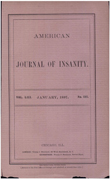Structured interview data on 35 cases of dissociative identity disorder in Turkey
Abstract
OBJECTIVE: The aim of this study was to describe the clinical features of dissociative identity disorder in a group of Turkish patients as assessed with a structured interview. METHOD: Thirty-five consecutive patients at the dissociative disorders program of a university psychiatric clinic who met the DSM-IV criteria for dissociative identity disorder were included in this study. The subjects were assessed with the Turkish versions of the Dissociative Disorders Interview Schedule and the Dissociative Experiences Scale. A descriptive analysis of the clinical features was carried out. RESULTS: Most (88.6%) of the patients were women. The mean age of the group was 22.8 years. Childhood physical or sexual abuse was reported by 77.1% of the patients. The mean Dissociative Experiences Scale score was 49.1. The patients reported an average of 12.5 somatic symptoms, 6.2 Schneiderian symptoms, 10.0 secondary features of the disorder, 3.8 borderline personality disorder criteria, and 4.1 extrasensory experiences. CONCLUSIONS: Dissociative identity disorder has a stable, consistent set of features throughout North America, in the Netherlands, and in Turkey. Cross-cultural research using standardized assessment measures will be invaluable in further illumination of the validity of this widely neglected psychiatric category.
Access content
To read the fulltext, please use one of the options below to sign in or purchase access.- Personal login
- Institutional Login
- Sign in via OpenAthens
- Register for access
-
Please login/register if you wish to pair your device and check access availability.
Not a subscriber?
PsychiatryOnline subscription options offer access to the DSM-5 library, books, journals, CME, and patient resources. This all-in-one virtual library provides psychiatrists and mental health professionals with key resources for diagnosis, treatment, research, and professional development.
Need more help? PsychiatryOnline Customer Service may be reached by emailing [email protected] or by calling 800-368-5777 (in the U.S.) or 703-907-7322 (outside the U.S.).



